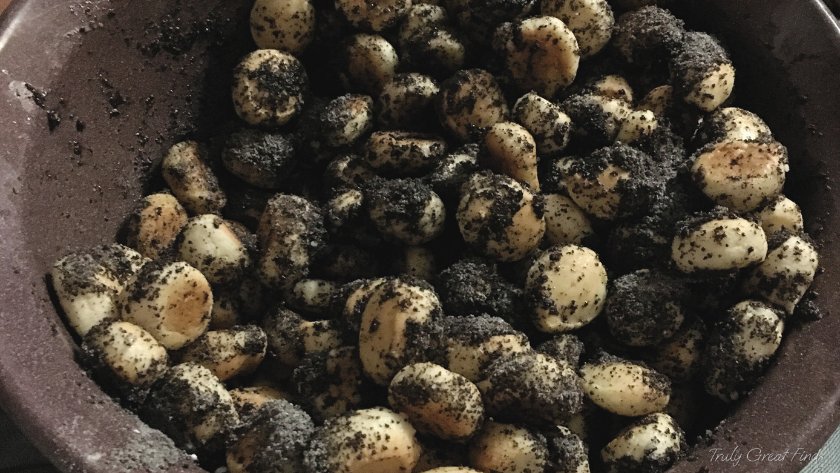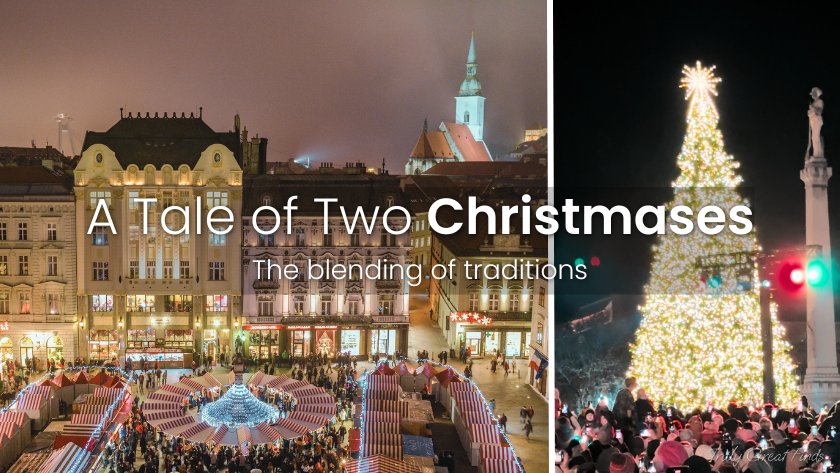Thank you for visiting! This post may contain affiliate links, which means I receive a small commission if you make a purchase using these links (at no extra cost to you). As an Amazon Associate, I earn from qualifying purchases.
Growing up in Slovakia, Christmas was an entirely different experience compared to the States. Today, kids wait for Santa in a flurry of cookies, decor, stockings, and the occasional elf on the shelf, but back in Slovakia, the holiday season has a unique charm that I love.
Like in the U.S., Slovak Christmas traditions vary by family, religion, and region, but some customs hold true across much of Slovakia. Unlike the U.S., we do most of our celebrating on December 24th. The 25th is spent more quietly, visiting friends and family, and reflecting on the holiday’s meaning. Here’s my tale of two Christmas traditions and how we celebrate the holiday now.
The Days Leading Up to Christmas
Our Slovak Christmas season kicks off with Advent, which has deep significance for many, especially Roman Catholics. Our family celebrated with a wreath, lighting one candle each Sunday before Christmas. It’s a time for spiritual preparation—but also the cleaning, baking, and shopping that come with the holidays.
One of my favorite traditions was celebrating St. Nicholas’ Day on December 6th. Known as Svätý Mikuláš in Slovakia, he’s a pretty big deal. On the night of December 5th, kids leave their shoes by the door or windowsill, and Svätý Mikuláš fills them with sweets and fruit if they’ve been good. My husband chuckles every year at the idea of putting treats in our (sometimes stinky) shoes, but I loved it as a child—and now, my kids do too.
Then there are the Christmas markets. In early December, town squares transform into bustling bazaars filled with handmade crafts, delicious foods, and mulled wine. You walk around in the crisp winter air, surrounded by the scent of roasted nuts and sweets, with music, ice skating, and families sharing holiday cheer. Christmas markets bring a unique sense of tradition that I miss here in the U.S. I could spend hours just wandering, mulled wine in hand, soaking up the warmth and energy.

Carp and Christmas Eve Traditions
As we got closer to Christmas Eve, the food prep kicked into high gear. But here’s the catch (pun intended), instead of turkey or ham, our traditional headliner for the Christmas meal is…carp. Yes, you read that right…the fish that you rarely see on menus in the U.S. and have probably never eaten. Street vendors set up big tanks filled with carp to sell. When we lived in Europe, my kids loved watching those hefty fish swim around like they were auditioning for some fishy version of Santa’s sleigh team.
My parents would buy a couple of fish, fill our bathtub with water, and suddenly we’d have a temporary aquarium. My sisters and I would hover over the tub, entranced. But on Christmas Eve morning, it was time to say goodbye and prepare the main course. I wasn’t a fan of carp myself—I always had a milder fish fillet instead—but carp is a Slovak holiday staple, loved for its unique taste and tradition.
Decorating was also different. Unlike the U.S., where decorations go up early, in Slovakia the tree and décor only went up a day or two before Christmas. Putting the tree up too early was considered “improper”—after all, what would the neighbors think? We kept it simple with a tree and maybe a wreath, but we also hung sweets and cookies on the branches, which we’d finally get to eat when we took the tree down, usually after January 6th. Though my holiday decor today might be a bit more “Winter Wonderland,” I’ll always remember the simple joy of my childhood Slovak Christmas.

Christmas Eve Slovak-Style
For Slovaks, Christmas Eve—Štedrý deň, or “Generous Day”—is the main event. The evening itself is called Štedrý večer, and it’s when families gather for a festive meal and, of course, presents. Growing up, we’d spend Christmas Eve watching fairy tales on TV while my mom cooked up our special meal. A religious tradition called for us to fast all day, though for me, it mostly meant smelling all that delicious food without being able to nibble—a true test of patience!
When evening finally arrived, we’d start by lighting the Christmas tree and then sit down for the big meal, called Velija. Our multi-course feast varies a bit from region to region. We’d always begin with a blessing, followed by dishes like Kapustnica (cabbage soup), various vegetable soups, potato salad, and of course, the infamous carp and other types of fish for the less adventurous. We’d also have rice pudding, bobalky (soft pieces of bread soaked in butter, powdered sugar, and poppy seeds), and plenty of medovníky…spiced honey cookies that everyone bakes during the holidays. Some families even made ten or more varieties of cookies—each a little work of art to share with friends and visitors throughout the season.
After dinner, it was finally time for presents! My sisters and I were so excited we’d often rush through our meal just to get to the gifts. The presents were simple but treasured, and once we’d opened them, we’d often sneak back to the kitchen for seconds. Midnight Mass was a popular tradition, too. Afterward, people would visit family or neighbors to exchange small gifts and holiday cheer.
And here’s a fun twist…in Slovakia, it’s not Santa who brings the gifts—it’s Baby Jesus (or Ježiško). Slovak children believe that Ježiško delivers presents through the window while everyone’s at the table, mid-feast. No sleigh, no chimneys—just a little baby slipping gifts in when no one’s looking.

Christmas Day and Beyond
Christmas Day and the 26th are much quieter—a time for relaxing, visiting family, and enjoying the season. We’d often go to church to see nativity scenes lovingly displayed in nearly every parish. It was a beautiful, reflective time spent with loved ones—a reminder of what the holiday season is truly about.
There’s also a fascinating tradition called Jasličkári, or Betlehemer, where young men go from house to house, telling stories while dressed in costumes. Adult beverages are often a part of the storytelling, bringing warmth to each home they visit. The fun part is when they’re joined by a “Christmas Monster” called Starý, meaning “the old one.” Think of him as a Slovak twist on Krampus, meant to keep kids in line. Dressed in eerie costumes that represent winter’s harshness, Starý added a little suspense to the season. As kids, we were definitely a bit spooked, but looking back, it’s one of those quirky traditions that made Christmas unforgettable.

Blending Traditions in the U.S.
Now that I live in the U.S., our Christmas is a blend of both worlds—celebrated on the 24th and 25th. We’ve incorporated elements of our Slovak Christmas meal on Christmas Eve (without the carp!). We have a circle of Slovak friends that we get together with…enjoying many of the menu items we’re used to. It’s a tradition that gives us all a little taste of home each year. Once dinner is finished and we’re back home, we let our kids open a few of their gifts.
During December, another Slovak tradition we’ve added is St. Nicholas Day on December 6th, when my kids eagerly check their shoes for treats from Svätý Mikuláš. We also celebrate with Advent Calendars, American Christmas movie classics…even Sparkle makes an appearance throughout December. And ever since the girls were born, we’ve created a family Christmas movie to help us remember each special year. It’s a wonderful mash-up of Slovak and American traditions that makes the season magical and uniquely ours.
Our holidays may look different from my childhood, but we’re creating something just as special—a blend of the meaningful traditions I cherish from Slovak Christmases with the sparkle and fun of the American version. And love that we’re carrying forward the traditions I’ve held dear while making space for new ones.
This post may contain affiliate links, which means I receive a small commission if you make a purchase using these links (at no extra cost to you). As an Amazon Associate, I earn from qualifying purchases.






